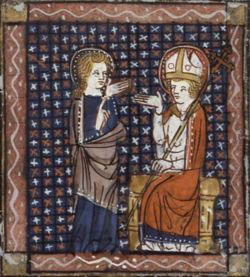
Feastday: November 13
Birth: 370
Death: 444
St. Brice was raised by St. Martin of Tours at Marmoutier and also known as Britius. He became a vain, overly ambitious cleric, holding Martin in great contempt. Despite Brice's attitude, Martin was most patient with him, and in time, in great remorse, he asked Martin's forgiveness for his attitude toward him. He succeeded Martin as Bishop of Tours in 397 but reverted to his old ways, neglected his duties, was several times accused of lackness and immorality. Though cleared of the latter charge, he was exiled from his See. He went to Rome and in the seven years of his exile there, repented and completely changed his life style. When the administrator of his See, in his absence died, he returned and ruled with such humility, holiness, and ability, he was venerated as a saint by the time of his death. His feast day is November 13th.
Saint Brice of Tours (Latin: Brictius; c. 370 – 444 AD) was a 5th-century Frankish bishop, the fourth Bishop of Tours, succeeding Martin of Tours in 397.
Background
Brice was a contemporary of Augustine of Hippo and lived in the time of the Council of Ephesus. Gaul was part of the Roman Empire, where Christianity was the official state religion since the end of the 4th century, and was in the process of advanced Christianization. However, the Western Roman Empire was already very close to collapse, and in the course of the migration of peoples in the fifth century, various Germanic empires formed; the time was politically rather uncertain.
Early life
According to legend, Brice was an orphan. He was rescued by Bishop Martin and raised in the monastery at Marmoutier. He became Martin's pupil, although the ambitious and volatile Brice was rather the opposite of his master in temperament. Brice became a monk and later, Martin's archdeacon.
In one account, when Martin prophesied that Brice would become his successor as bishop, but would have many difficulties, the clerics of Tours, where the thought of such a bishop did not arouse enthusiasm, asked Martin to send the troublemaker away; but Martin replied: "If Jesus could come to terms with Judas, then I can certainly come to terms with Brice."
Career
 Saint Brice, Calimers
Saint Brice, Calimers
When Martin died in 397, Brice succeeded him as Bishop. As Bishop of Tours, Brice performed his duties, but was also said to succumb to worldly pleasures. He was repeatedly accused of secular ambition, and various other mistakes during this time, but Church official investigations each time released him.
In the thirtieth year of his episcopate, a nun who was a washerwoman in his household gave birth to a child that owing to calumny, was rumored to be his. He submitted to a ritual of carrying hot coals in his cloak to the tomb of St. Martin, showing the unburned cloak as proof of his innocence. The people of Tours, however, did not believe him and forced him to leave Tours or be stoned by them. He could return only after he had travelled to Rome and been absolved of all his sins by the Pope.
After seven years of exile in Rome, Brice returned to Tours, completely exonerated by the pope. During his absence several other bishops had been appointed to Tours; but when he came back, the last of them had just died and Brice resumed his duties. He served with such humility that on his death seven years later he was venerated as a saint.
Veneration
Brice is described in various biographies as a controversial figure. Church historians see in the various relevant legends an expression of the tensions between the regular clergy and the secular priests in Tours at that time. His bones were transferred by Gregory of Tours to Clermont and are now in the church of San Michele in Pavia. Churches were named after him.
Feast day
His memorial day is 13 November. The killing of the Danes in England on 13 November 1002 is called the St Brice's Day massacre.
In the town of Stamford in Lincolnshire, 13 November, St Brice's Day, was traditionally the day that a bull-running took place.
Iconography
St. Brice is depicted as a bishop, with glowing coals in his robe or with a baby in his arms.
Notes
- ^ Also scribed as Bricius, Britius, Brixius, Briktius, or Briccius.





